Creating a successful marketing strategy for Amazon is NOT easy.
Many Amazon sellers are struggling to grow their eCommerce businesses.
On top of that, hundreds (if not thousands) of new products are added each day in the marketplace.
This is why I prepared a simple (yet complete) guide on how to create a successful Amazon marketing strategy.
So if you want to get more Amazon customers and grow your Amazon business, you’ll need this guide.
Let’s dive right in!
Table of Contents
Chapter 1: Amazon SEO
Even if shoppers do not make their final purchase with Amazon, buyers will consult with the retail giant to discover new products and to check prices so they have a comparison when shopping in other eCommerce sites.
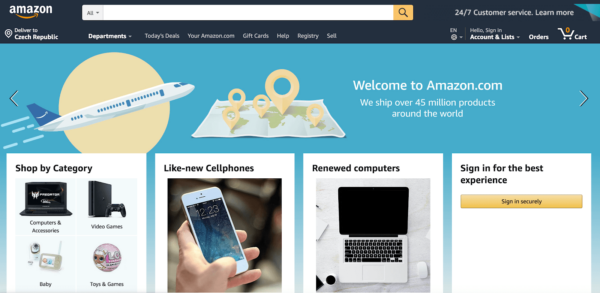
Image Source: Amazon
Many will start their product searches on Amazon, which means they aren’t going directly to Google as they have in the past. Not only is Amazon an eCommerce giant but also a search engine.
This makes it extremely important to create a solid Amazon marketing strategy to ensure your products are being pulled up at the top of the search results and keep consumers coming to your product page.
Like Google, Amazon has its own algorithm for calculating SEO on their site called A9. Its job is to rank the product listings by relevance, keywords, and optimized content.
Check out our blog about Amazon Ranking and more information on Amazon’s A9 algorithm.
Search Engine Optimization (SEO) is one of the best-known methods for your online marketing needs. SEO helps you appear higher than other sellers in the search results.
The higher you can appear in the search results, the more views your products will get which leads to a higher revenue overall. The following ways can help increase your visibility through SEO.
Essential research and primary keywords
A lot of people overlook this step, however, it should be one of the most important aspects. When a potential buyer clicks on a listing, they will first see the product image and its title.
You’ll need to think like the buyer – why would they be searching for your product? How does the average person search and what are they typing?
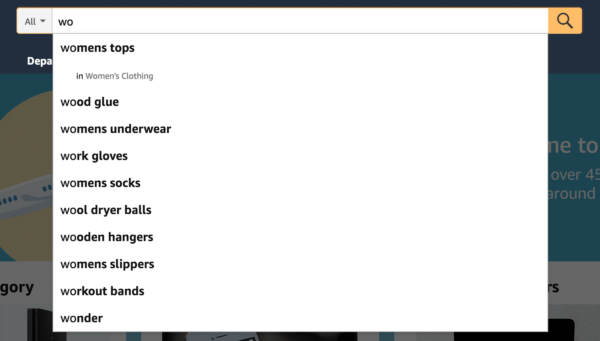
Image Source: Amazon
You will want to choose a primary keyword that has a high search volume, but also a low-competitiveness so that your listing doesn’t blend in with other products.
Do research on the keywords or search terms that Amazon visitors use and incorporate your top keyword in the title of your product.
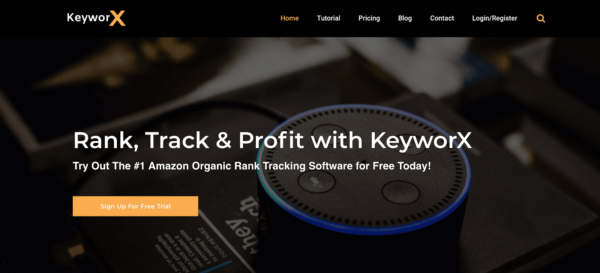
Image Source: Keyworx
Author’s Note: We will discuss keyword planning more and provide you with a list of other tools in Chapter 4!
High-Quality Photos for Products
Now that you have an inviting title to get consumers to click your link from Amazon’s search results, you need to factor in high-quality photos for your product display and SEO strategy.
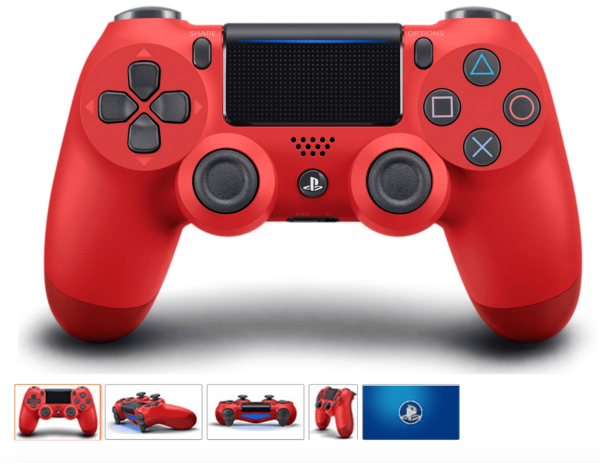
Image Source: Amazon
You will want to ensure your photos are professional quality and clearly show the details of the product. Some tips when incorporating images are:
- Make sure they are In focus with good lighting
- High-resolution photos (at least 1000 pixels wide)
- Include multiple angles and don’t include extra objects that you don’t sell or that don’t come with your product
- Have the product 80% of the frame with a white background
We’ve gathered even more information about this in our be-all-end-all guide to Amazon product photography.
You can also add videos to show off product uses, features and anything else that can’t be seen in a photo.
The more information you can provide your consumers and the better you showcase your products will lead to more success during sales and a higher ROI.
Product description and bullet points

Image Source: Amazon
While product description doesn’t have an effect on boosting your SEO, it will help buyers see that they have found a relevant page for their needs.
Describe the benefits of your product, not just its features. Work your relevant keywords into the description in a natural way so that it doesn’t seem obvious to the viewer.
A convincing bullet points section can turn your clicks into conversions.
Amazon vendors are allowed 10 bullet points, while sellers can only have 5 bullet points. Use this space to answer common questions or address any concerns other buyers may have had.
You’ll find examples and templates to reference in our guide on how to write product descriptions.
There are many other things you should consider when it comes to Amazon SEO.
The ones I outlined happen to be some of the most critical ones.
To get a complete overview of what Amazon SEO stands for, take a look at the following content piece I’ve created for you:
→ Amazon Best Sellers Rank (BSR) + 24 More Amazon Ranking Factors ←
For now, let’s move to the next chapter: Amazon PPC
Chapter 2: Amazon PPC (Amazon Advertising)
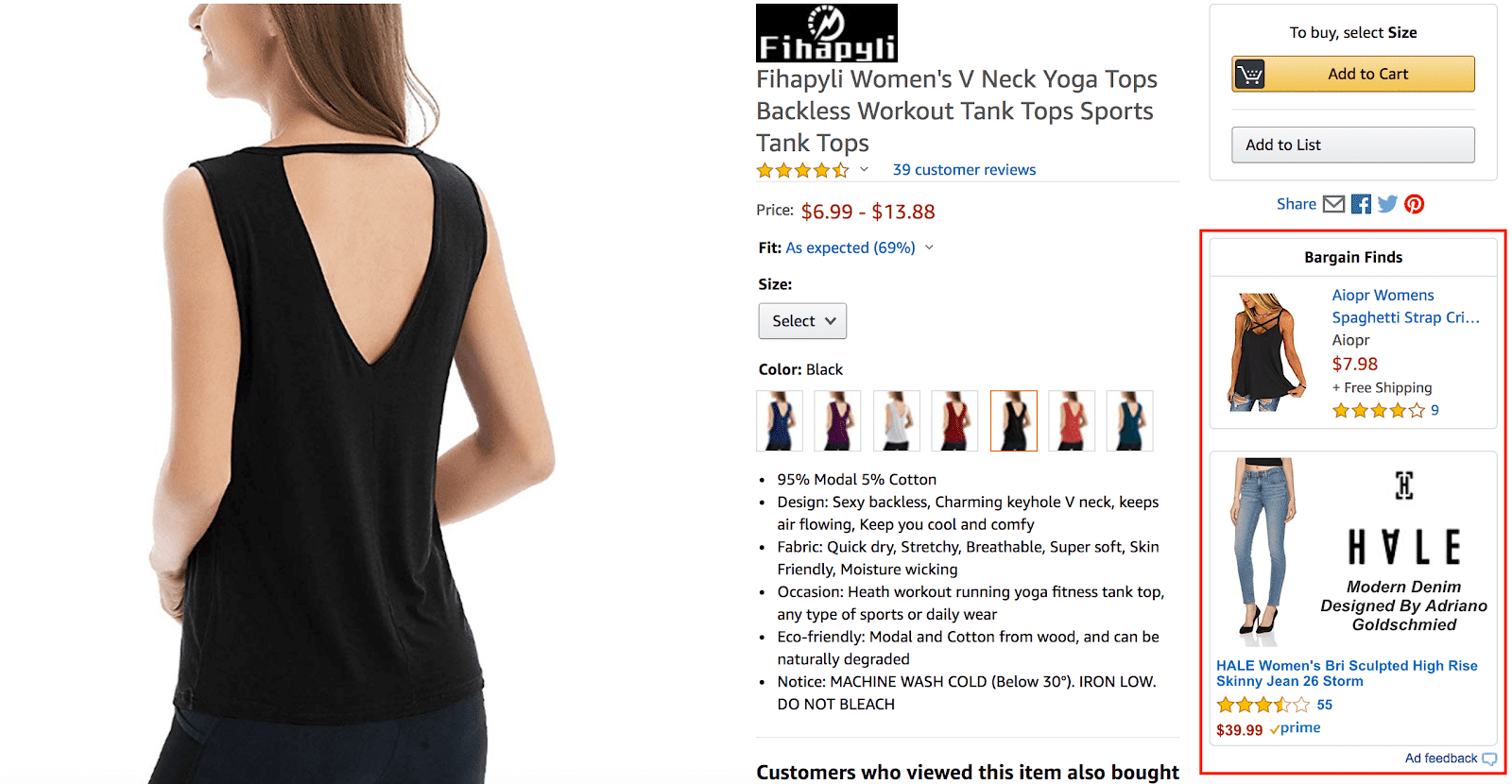
Image Source: Amazon
Amazon advertising, formerly known as Amazon Marketing Services (AMS), allows sellers to advertise straight from the platform. It is similar to Google ads in the sense that the advertiser does not pay unless the ad is clicked.
Also, similar to Google, AMS lets buyers choose how they want their ads displayed. You have the options of product display ads, sponsored product ads and headline search ads.
Product Display Ads
Product display ads can show up on the side or at the bottom of an Amazon search results page. They can also show up on the side of relevant product pages.
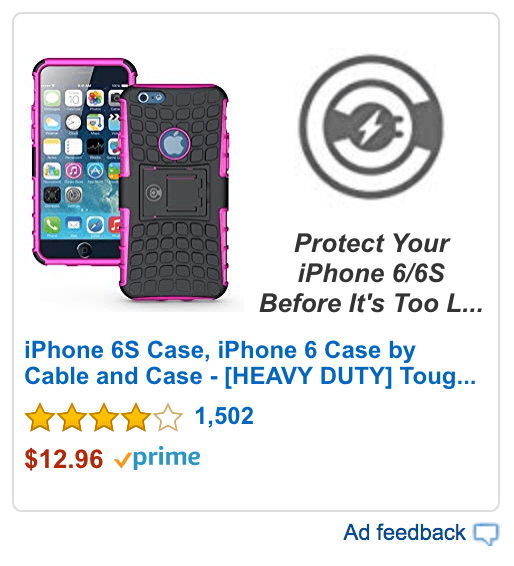
Image Source: Amazon
You can identify which products are ads by the small grey outline and ad feedback button underneath.
Clicking on these ads will take you to the individual amazon product pages.
Sponsored Product Ads
Sponsored ads increase the visibility of your products by showing up on the first page of the search results and related product pages.
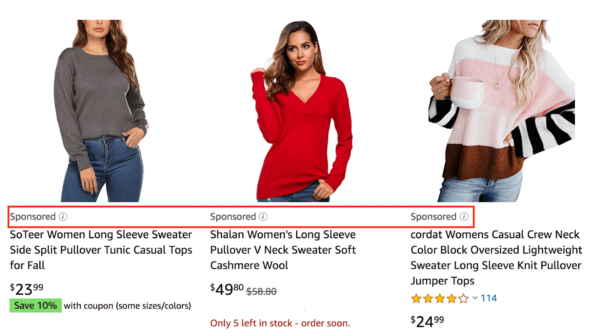
Image Source: Amazon
This increased visibility leads customers to your product from similar products they are showing interest in and drives a higher conversion rate.
Professional sellers, vendors, book vendors, Kindle Direct Publishing (KDP) authors, and agencies are all eligible to sell using sponsored ads.
In 3 simple steps, you can become a professional seller through Amazon.
In one case study, an eCommerce agency led holiday sales for a new party game through sponsored ads.
The party game, Awkward, achieved an 8% increase in sales from the previous year by focusing on tailoring keywords to be specific to the holidays, monitoring and increasing bids to stay competitive and using data from Amazon search tools.
For other helpful software, check out our complete list of Amazon seller tools.
Headline Search Ads
Headline search ads allow you to bring your own branding into Amazon’s website. These are the most customizable ads Amazon offers.
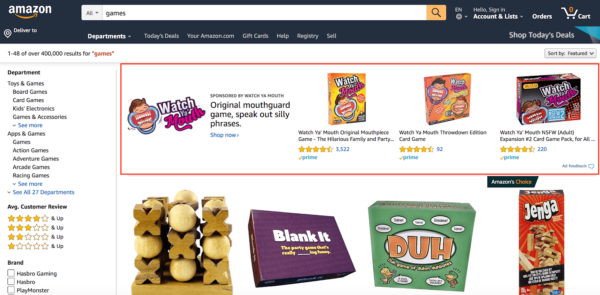
Image Source: Amazon
You can choose the ad text and instead of leading to a product page when clicked, these ads lead to a branded landing page with custom navigation, branded images and select products.
No matter which ad style you choose, make sure you have a clear digital marketing and advertising strategy before beginning.
This strategy should place your ads in front of a specific target audience and drive traffic to unique branded or product pages.
Chapter 3: Email Marketing & Social Media
One of the quickest ways to reach your potential buyer is through their email inbox and on their social media platforms.
Try to be authentic to your company and brand. When you have the vision of your brand in mind, that can help you choose different Amazon marketing strategies that work best for you.
Email marketing
A great email marketing strategy can help build your reputation with your customers and help them feel a sense of belonging to your organization.

Image Source: Gmail
After someone purchases a product, you should be collecting their information and either sending them a follow-up email or text message thanking them for their purchase.
Once you start to build that relationship, you can then periodically follow up with them. Ask for Amazon reviews or offer discounts for their next purchase, making sure you stay relevant in the buyer’s mind.
You can also run promotional deals that are only available to your email list to make your buyers feel special and show your appreciation for their purchase.
You’ll want to ensure you are not spamming your customers to where they unsubscribe from your email list. Follow up after purchases or after they’ve made contact.
This way they can be reminded again about your company and about other products you have that they might be interested in, instead of the email coming from out of the blue.
You can also incorporate a monthly/bi-monthly/ or quarterly newsletter that mentions your new products or offers a discount.
Newsletters are a great way to generate leads if your product link is within the email that links directly to your Amazon page.
You can research different email marketing automation software that can help make the process even simpler for you.
It can ultimately save you time and stress to stay connected with your customer base.
Either way, you will want to make sure there is some type of follow up that is happening once someone makes a purchase. More follow up will lead to more purchases in the future.
Social media
If you don’t already have a brand page on the major social media platforms (Facebook, Instagram, Twitter, Pinterest), then you will want to start creating them right away.
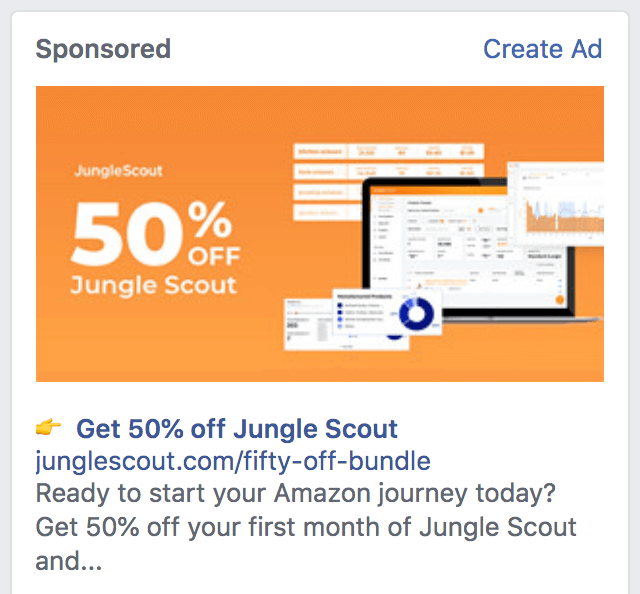
Image Source: Facebook
Different platforms have different demographics that you target. The potential buyers you can reach on Instagram might not be the same people you could reach on Pinterest.
Creating these social media profiles is one of the most direct avenues where you can connect with buyers and market your product to potential customers.
The average amount of time people spend on social media increases year over year.
One of the ways, besides sponsored posts, that Amazon uses their social media to promote products is through their Influencer program.
Social media influencers are a huge trend right now so you should look into joining the movement.
The partner influencer makes their own landing page with a collection of different Amazon products.
It’s great for marketing to an established fan base that you might not have been able to reach through your own social media channels.
Through sponsored posts on Facebook and Instagram, you can get your listing in front of people that are most likely to buy your product.
You can customize your audience by multiple demographics and locations to drive traffic to your Amazon page through third-party social media applications.
Chapter 4: Product Listing Optimization
As mentioned earlier, Amazon is not only an eCommerce website anymore but also a search engine where many consumers begin their shopping journey.
This is why it is extremely important to understand how optimization of your products works and why it is beneficial to your business.
Why is product optimization important?
Simple—the higher you rank, the more you sell!
Product listing optimization consists of two parts:
- Keywords—to help rank for search terms that buyers search for.
- Images, title, and description – to generate greater conversion rates.
For help finding the right keywords, read our guide on the 19 best Amazon keyword research tools.
The problem some sellers run into is focusing too much on optimization of the listing instead of the actual product. Never forget the driving factor behind Amazon’s A9 algorithm – quality products.
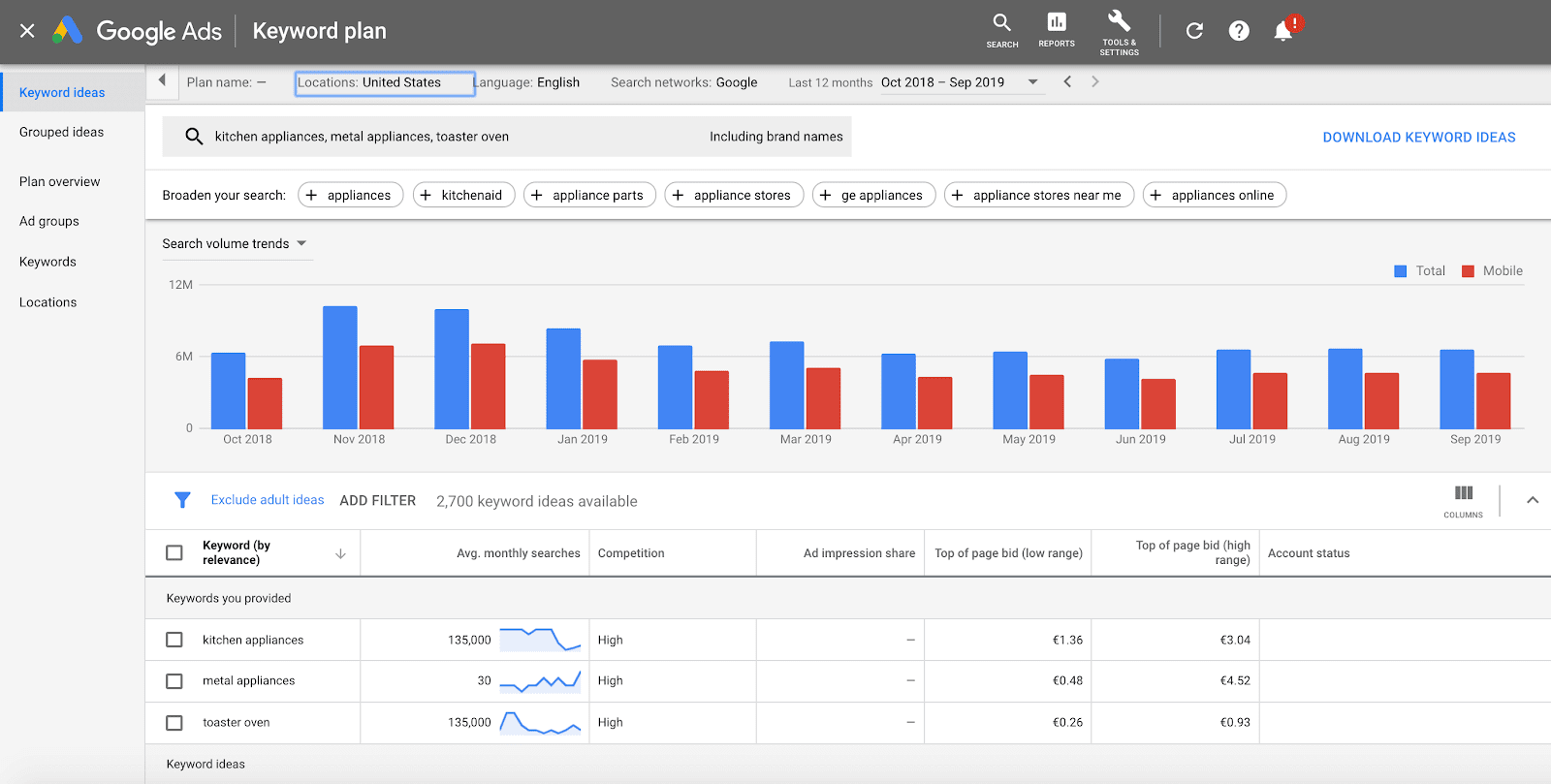
Image Source: Google Keyword Planner
Once you have researched your keywords using Google Keyword Planner or any of the other tools mentioned in our guide on the 19 best Amazon keyword research tools, you can start optimizing the other areas of your product.
Product Listing Optimization Checklist:
- Title
- Features
- Images
- Description
- Search Terms
Author’s Note: If you are struggling to come up with your product titles, try this formula:
Key benefit of your product + primary keyword + for < target audience or demographic > | USP + Function + keyword (if you couldn’t fit in earlier or secondary) – Brand Name + other secondary keywords.
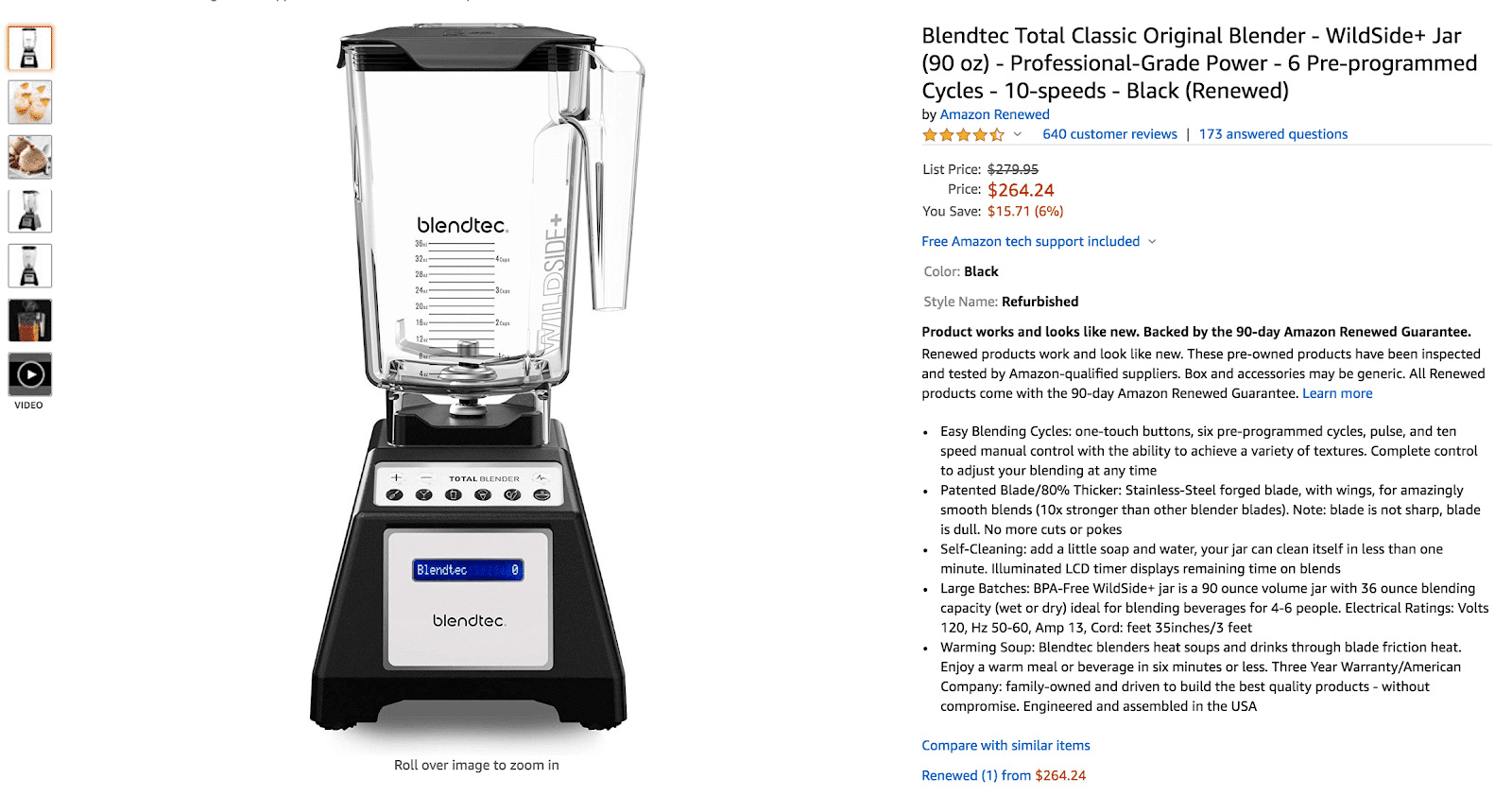
Image Source: Amazon
We discussed optimizing the product images and description back in Chapter 1 but here are some further do’s and don’ts for product optimization:
Do’s
- Include your brand name and primary search terms in the title
- Mention unique selling points in the title
- Incorporate keywords into your product description bullet point and order them from most important to least
- Add an infographic about the product’s benefits to help generate more sales.
- Give only clear, descriptive and factual information
Don’ts
- Use subjective adjectives in your title
- Include time-sensitive or subjective comments
- Overuse keywords or exclamation points
- Add shipping or promotional information to your product description
- Include the seller name or brand name as a search term
- Use variations of the product name or misspellings as search terms
Aside from the quality of your product and how well the product listing is optimized, you also have to monitor and encourage the conversation around your products.
Everything must seamlessly come together to give your products the highest chance of success.
We’ll discuss how to control the customer experience next.
Chapter 5: Customer Experience
You might have the best marketing channels online and the most creative strategy to try and increase leads, but at the end of the day, what matters most is your customer’s experience.
People will remember how you made them feel and a negative experience can leave a lasting impact for years to follow.
Consider incorporating the following tips to make sure your customer service game is top-notch:
Respond to Negative Reviews
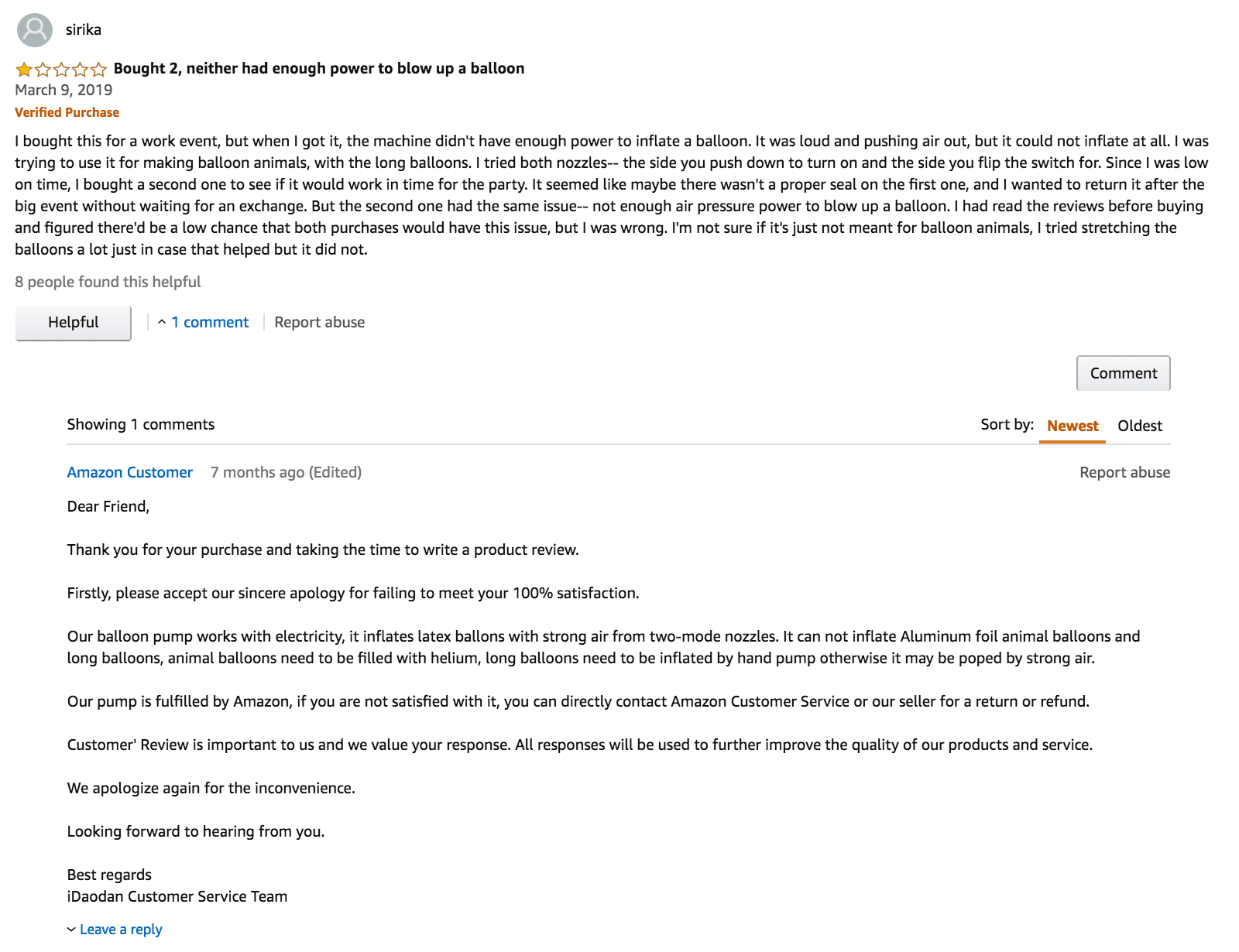
Image Source: Amazon
It’s extremely important to act fast and respond with sincerity when someone leaves a negative Amazon customer review on your listing.
These reviews are public on your Amazon product page and new potential buyers can see these and feel discouraged from buying the same product.
When you address the negative review, it shows you are being transparent with your customers and can build some of the trust back.
Sometimes by contacting the buyer to see if there’s anything you can do to help resolve the issue might lead them to update their review to something not as damaging.
Have Good-Quality Products
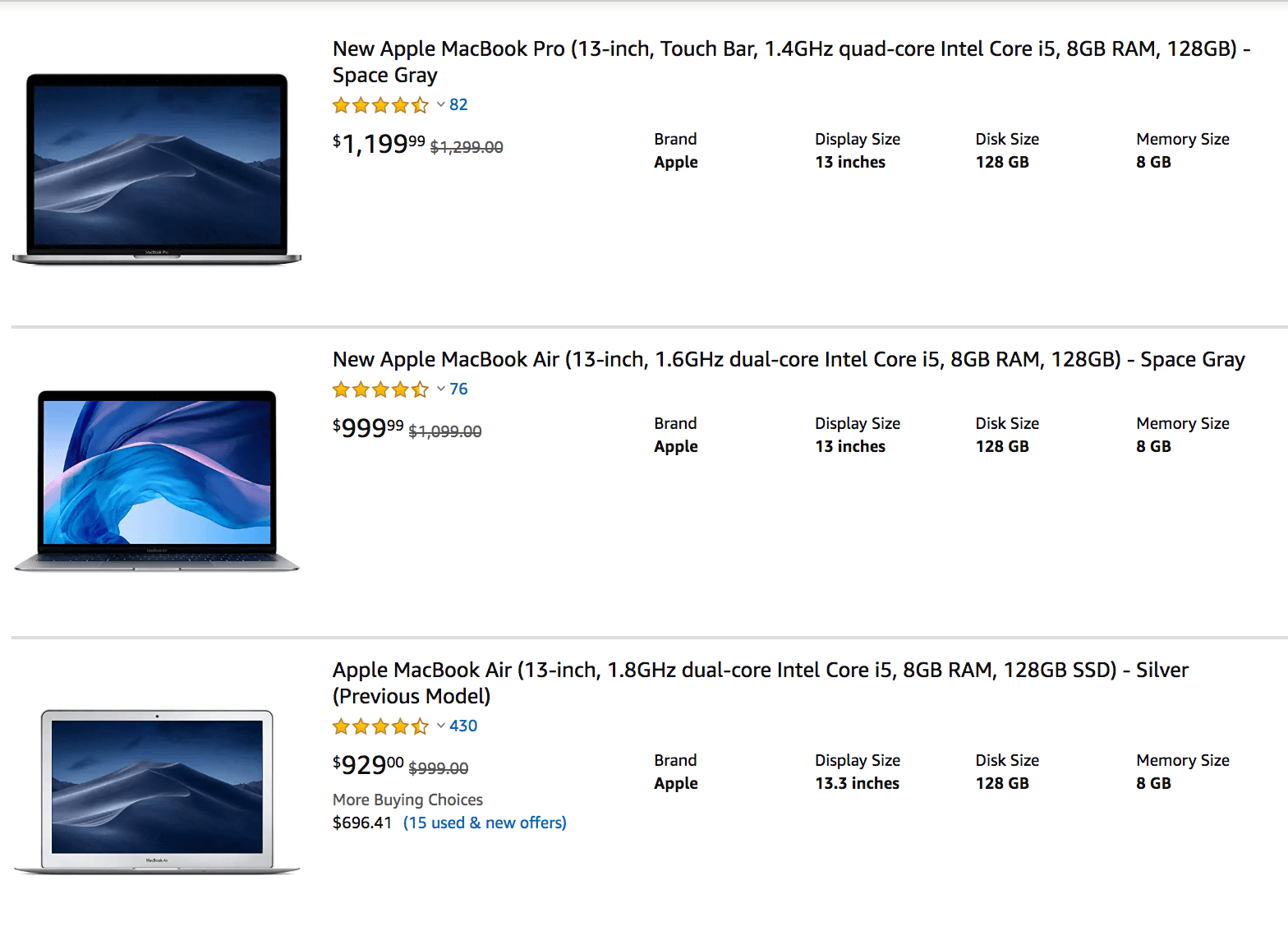
Image Source: Amazon
This might seem obvious but invest in high-quality products to ensure your product matches the potential buyer’s expectations.
You might be able to make some money deceiving people but eventually it will catch up through negative reviews and word of mouth that discourages the buying of your product.
You want the product to accurately match the description that you described. Honesty and good quality products are the foundation for succeeding on Amazon.
Positive word of mouth can spread quickly and can help you increase your revenue out of the blue.
Offering Customer Support
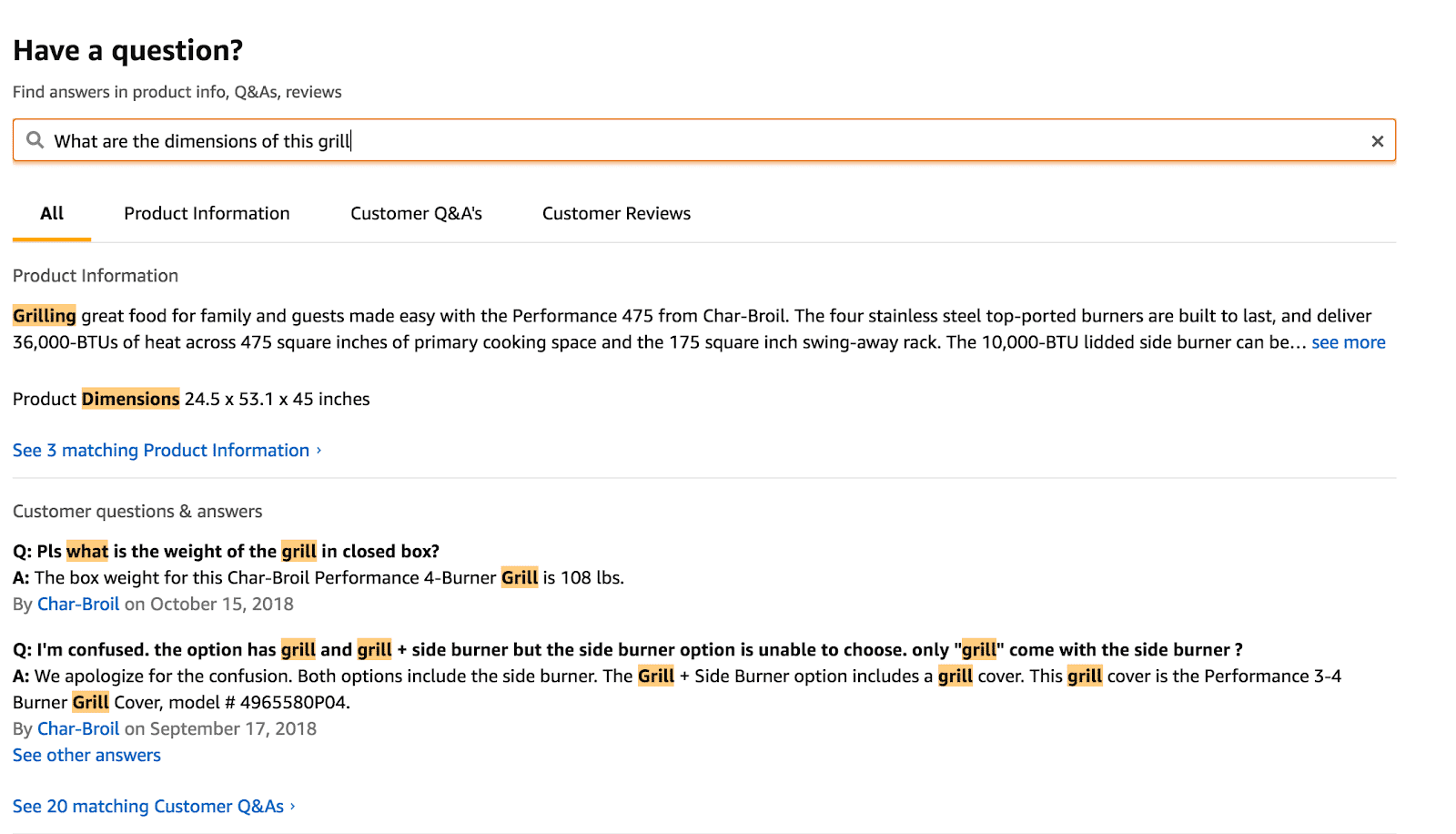
Image Source: Amazon
The more support you can provide your customers, the more they will appreciate your company and be more likely to continue buying products in the future.
Having a FAQ’s section on your Amazon product page will help buyers get answers to commonly asked questions right away. You can also use this section to address any problems you may have had and the steps you took to resolve the issue.
Providing the answers to frequently asked questions directly on your site shows that you have the customer’s needs in mind and that you are willing to help.
When you get enough buyers, they can also provide their unbiased answers to these questions to help start the feeling of community and it’s from a verified buyer.
You can also try to use automation through chatbots to help your customers receive a quick answer to a commonly asked problem, without you having to answer it over and over again.
Wrapping this up…
If you’ve read so far, then you know that creating a successful Amazon marketing strategy requires a lot of work.
There are many things involved and several others that you can’t control.
Besides successfully running your Amazon PPC, Amazon SEO, Email marketing or social media campaigns, you should pay close attention to the quality of your products.
Selling products that are not high-quality won’t get you anywhere in the long-term.
Try to build a customer-centric company, rather than a sales or marketing-focused one.
After all, providing consumers with a GREAT customer experience is the best marketing you can do.
Now I’d like to hear from you:
What have you achieved so far with your Amazon marketing strategy? What worked and what didn’t work?
Let me know by leaving a comment below!
Additional Resources you might be interested in:
- 20 Amazon Seller Forums to Succeed in Amazon FBA
- How to Use Facebook Ads to Grow Your Amazon Business
- The 6 Pillars of Amazon Product Listing Optimization
Special Offer…
If you’re looking for a more in-depth Amazon marketing plan, there’s a new section covering Amazon marketing tactics to help you launch new products in our brand new Amazon business course. We’re helping first time entrepreneurs launch their very own physical product Amazon business. If you want to check that out and see if it’s right for you click here…
